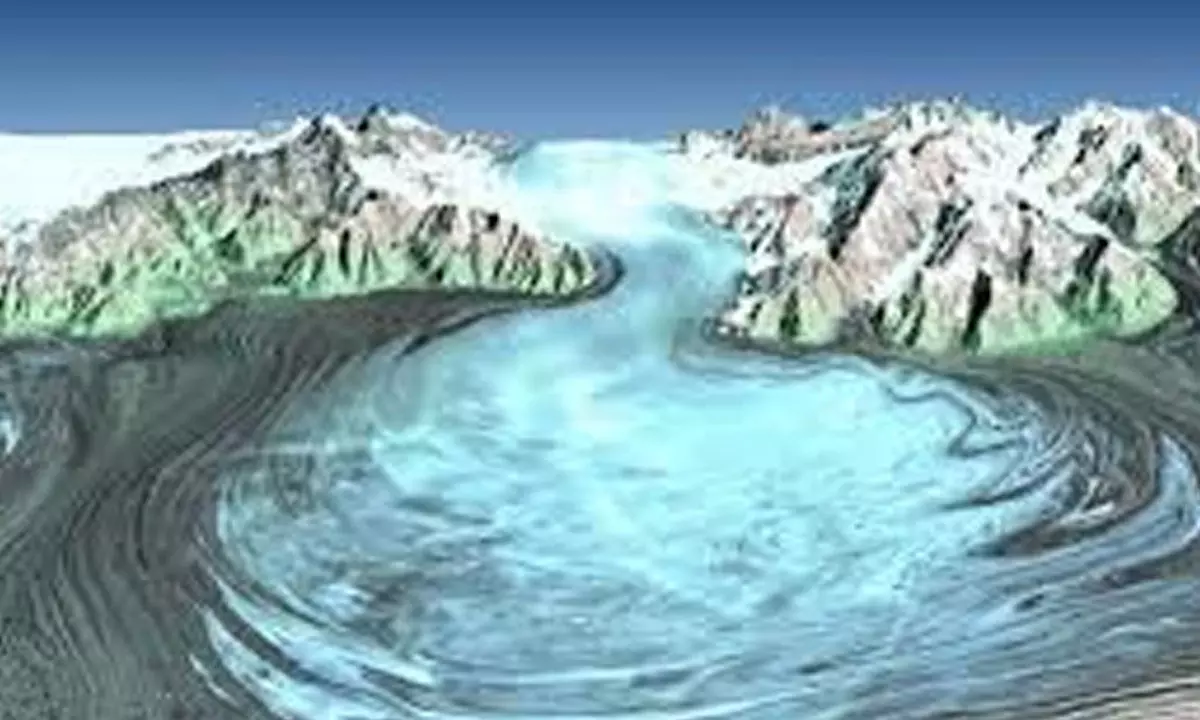Live
- 7-Year-old girl sexually assaulted in Tirupati
- PM Modi highlights govt's efforts to make Odisha prosperous and one of the fastest-growing states
- Hezbollah fires 200 rockets at northern, central Israel, injuring eight
- Allu Arjun's Family Appearance on Unstoppable with NBK Breaks Viewership Records
- Unity of hearts & minds essential for peace & progress, says J&K Lt Governor
- IPL 2025 Auction: I deserve Rs 18 cr price, says Chahal on being acquired by Punjab Kings
- EAM Jaishankar inaugurates new premises of Indian embassy in Rome
- Sailing vessel INSV Tarini embarks on second leg of expedition to New Zealand
- Over 15,000 people affected by rain-related disasters in Sri Lanka
- IPL 2025 Auction: RCB acquire Hazlewood for Rs 12.50 cr; Gujarat Titans bag Prasidh Krishna at Rs 9.5 crore
Just In
Himalayan mountains in dire straits: Study


Overall, the Himalayas have already lost more than 40 per cent of their ice, and are likely to lose up to 75 per cent by the end of this century. The western Himalayas had lost 8,340 sqkm of permafrost area between 2002-04 and 2018-20; about 965 sqkm of area disappeared in the Uttarakhand Himalayas between 1970-2000 and 2001-17
Between 2013 and 2022, the Himalayan region in India accounted for 44 per cent of all the disasters reported in the country. Floods, landslides and thunderstorms – 192 in all – constituted the bulk of these incidents. In fact, the cloudbursts and torrential rains experienced in the region in 2023 are curtain-raisers to a future that is already upon us, and will become more pronounced with every passing year.
This assessment of the Himalayan region and the impacts of climate change that it is encountering is a key focus of the recently released State of India’s Environment 2024 report. The report is prepared and released every year by Centre for Science and Environment (CSE) and Down To Earth magazine.
This year, the SOE 2024 (as the report is referred to in short) was unveiled at the Anil Agarwal Dialogue, an annual conclave of environment-development journalists attended by over 100 mediapersons and subject experts from across the country. The Dialogue is organised every year by CSE.
Between April 2021 and April 2022, 41 incidents of landslides were recorded across the country: 38 of these happened in Himalayan states, with Sikkim witnessing the highest number (11).
Writes Kiran Pandey, head of CSE’s Environment Resources Unit in the recently released CSE report: “A close look at the data shows an uncomfortable trend. In recent decades, these disasters are occurring more frequently and getting more severe, causing a significant loss of life and damage to property.”
The worst long-term – and relentless -- damage isbeing seen in the upper reaches of the Himalayas. The rise in average surface temperatures in the Himalayas is causing glaciers to melt rapidly and retreatat an accelerating rate. The Hindu Kush Himalayas has seen a 65 per cent faster loss of glacier mass, according to a study by the Nepal-based International Centre for Integrated Mountain Development (ICIMOD). During 2010-19, glaciers in the region lost a mass of 0.28 metre of water equivalent per year (m we) in comparison to 0.17 m we per year in the period 2000-09. The Karakoram Range, which was known to be stable, has also started showing a decline in glacier mass, losing 0.09 m we per year during 2010-19.
The State of India’s Environment 2024 report quotes Izabella Koziell, ICIMOD’s deputy director general: “The glaciers of the Hindu Kush Himalaya are a major component of the Earth system. With two billion people in Asia reliant on the water that glaciers and snow here hold, the consequences of losing this cryosphere are too vast to contemplate. We need leaders to act now to prevent catastrophe.”
Overall, the Himalayas have already lost more than 40 per cent of their ice, and are likely to lose up to 75 per cent by the end of this century. The western Himalayas had lost 8,340 sqkm of permafrost area between 2002-04 and 2018-20; about 965 sqkm of area disappeared in the Uttarakhand Himalayas between 1970-2000 and 2001-17. The loss of permafrost can lead to infrastructure damage. “We are already seeing the effects of this, for example, in landslides caused by thawing permafrost,” says Dr Miriam Jackson, ICIMOD’s senior cryosphere specialist, and one of the speakers at the Anil Agarwal Dialogue.

© 2024 Hyderabad Media House Limited/The Hans India. All rights reserved. Powered by hocalwire.com






